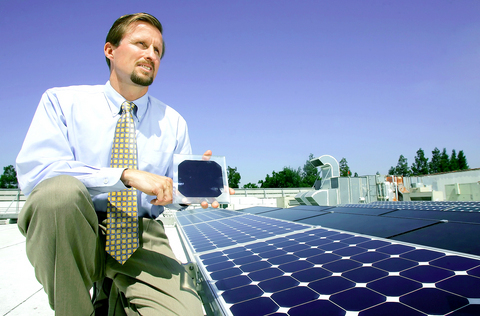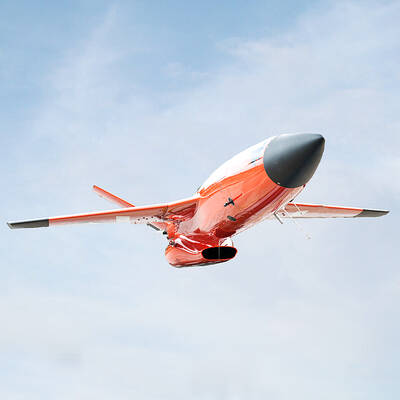As demand for clean energy rises around the world, the US' high-tech hub is looking to squeeze more money out of silicon.
Engineers and entrepreneurs in Silicon Valley are taking advantage of their expertise in computer chips to design and manufacture electricity-generating solar cells that they hope will be increasingly competitive with traditional energy sources such as coal and natural gas. Most solar cells and chips are made from the same raw material from which the valley gets its name.
"We're in the very early stages of a long build-out in solar technology," said Erik Straser, who heads the "cleantech" practice at the Menlo Park venture capital firm Mohr Davidow Ventures. "The potential is really enormous."

PHOTO: AP
Despite technological advances since the first photovoltaic cells were invented 50 years ago, solar is still two to three times more expensive than fossil fuels in the US and relies on government subsidies to compete.
But improving technology, falling costs, rising prices for fossil fuels, concerns about the electric grid's stability and worries about global warming are all raising interest in solar energy. The industry is expected to grow from US$11 billion last year to US$51 billion in 2015, according to a projection by Clean Edge Inc, a market research firm focused on clean technology.
And that's why Silicon Valley is getting involved.
This month, Applied Materials Inc, a Santa Clara company that manufactures chipmaking equipment, announced plans to sell tools for producing solar cells. The company projects the market for such gear will triple to US$3 billion over the next four years.
The company's equipment can be retooled for silicon solar wafers, while another of its technologies -- for making flat-panel displays -- can be applied to "thin film" solar cells sprayed onto glass and other flat surfaces.
"By lowering the cost and increasing the volumes, we think that solar power will become much more affordable in more places in the world," chief technology officer Mark Pinto said.
Cypress Semiconductor Corp of San Jose was one of the first Silicon Valley chipmakers to cross over into the solar sector.
Four years ago, Cypress founder T.J. Rodgers convinced his board to buy a majority stake in solar cell-maker SunPower Corp, founded by his former Stanford University classmate Richard Swanson.
Rodgers argued that Cypress' manufacturing technology could be used to reduce costs and expand production of SunPower's cells.
Cypress' investment is paying off. SunPower raised US$146 million when it went public last year, making it one of last year's most successful initial public offerings. Revenue has increased from about US$10 million in 2004 to a projected US$230 million next year, SunPower CEO Tom Werner said.
"The semiconductor and solar industries are very similar," Werner said. "It's just that the solar industry hasn't gotten to the same scale as the semiconductor industry."
Solar's expansion in Silicon Valley won't necessarily create lots of manufacturing jobs in the San Francisco Bay Area. Production primarily takes place in low-cost countries, mostly in Asia.
Only about 100 of SunPower's 1,300 employees work at its San Jose headquarters; the rest work at a new manufacturing plant in the Philippines.
Silicon Valley venture capitalists are also taking an interest in solar, part of their growing interest in companies that develop environmentally friendly technologies.
About US$1.4 billion in venture capital was invested in cleantech ventures during the first six months of this year, and US$1.6 billion was invested last year, according to the Cleantech Venture Network.
About one-third of that money was invested in Silicon Valley, said Carl Guardino, who heads the Silicon Valley Leadership Group.
"We all realize that green is gold," Guardino said.
"Venture capitalists are betting with their wallets that cleantech will play a significant role in Silicon Valley," he said.
So many valley companies, venture capitalists and entrepreneurs are rushing into the burgeoning solar industry that it's inviting comparisons to the early expansion of the microchip industry more than two decades ago.
"If there's anywhere in the world that can push the envelope on solar, it might very well be Silicon Valley," Clean Edge co-founder Ron Pernick said.
But the valley's rush to solar isn't without risk. The solar industry must first bring down costs significantly to persuade homeowners and businesses to install solar systems onsite rather than just buy electricity from the local utility.
The industry also faces a worldwide shortage of polysilicon created by the rapid expansion of solar. This year, for the first time, the solar industry is expected to consume more silicon than the computer chip industry.
Some valley solar startups are moving beyond silicon. Miasole of San Jose and Nanosolar Inc of Palo Alto are developing thin-film solar cells made from alternative materials like copper and selenium. Nanosolar has raised US$100 million in venture funding and plans to build what it says will be the world's largest solar-cell factory.

The US government has signed defense cooperation agreements with Japan and the Philippines to boost the deterrence capabilities of countries in the first island chain, a report by the National Security Bureau (NSB) showed. The main countries on the first island chain include the two nations and Taiwan. The bureau is to present the report at a meeting of the legislature’s Foreign Affairs and National Defense Committee tomorrow. The US military has deployed Typhon missile systems to Japan’s Yamaguchi Prefecture and Zambales province in the Philippines during their joint military exercises. It has also installed NMESIS anti-ship systems in Japan’s Okinawa

‘WIN-WIN’: The Philippines, and central and eastern European countries are important potential drone cooperation partners, Minister of Foreign Affairs Lin Chia-lung said Minister of Foreign Affairs Lin Chia-lung (林佳龍) in an interview published yesterday confirmed that there are joint ventures between Taiwan and Poland in the drone industry. Lin made the remark in an exclusive interview with the Chinese-language Liberty Times (the Taipei Times’ sister paper). The government-backed Taiwan Excellence Drone International Business Opportunities Alliance and the Polish Chamber of Unmanned Systems on Wednesday last week signed a memorandum of understanding in Poland to develop a “non-China” supply chain for drones and work together on key technologies. Asked if Taiwan prioritized Poland among central and eastern European countries in drone collaboration, Lin

The Chien Feng IV (勁蜂, Mighty Hornet) loitering munition is on track to enter flight tests next month in connection with potential adoption by Taiwanese and US armed forces, a government source said yesterday. The kamikaze drone, which boasts a range of 1,000km, debuted at the Taipei Aerospace and Defense Technology Exhibition in September, the official said on condition of anonymity. The Chungshan Institute of Science and Technology and US-based Kratos Defense jointly developed the platform by leveraging the engine and airframe of the latter’s MQM-178 Firejet target drone, they said. The uncrewed aerial vehicle is designed to utilize an artificial intelligence computer

Renewed border fighting between Thailand and Cambodia showed no signs of abating yesterday, leaving hundreds of thousands of displaced people in both countries living in strained conditions as more flooded into temporary shelters. Reporters on the Thai side of the border heard sounds of outgoing, indirect fire yesterday. About 400,000 people have been evacuated from affected areas in Thailand and about 700 schools closed while fighting was ongoing in four border provinces, said Thai Rear Admiral Surasant Kongsiri, a spokesman for the military. Cambodia evacuated more than 127,000 villagers and closed hundreds of schools, the Thai Ministry of Defense said. Thailand’s military announced that